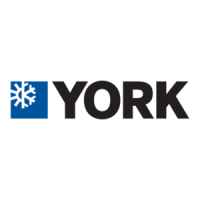YORK INTERNATIONAL 69
FORM 150.40-NM25
L. Be certain all control bulbs are inserted completely
in their respective wells and are coated with heat
conductive compound.
2. PANEL CHECKS
(POWER ON-BOTH SYSTEM SWITCHES “OFF”)
A. Apply 3-phase power and verify its value. (See Fig.
32.)
B. Apply 115VAC and verify its value on the terminal
block in the lower left of the Power Panel. Make the
measurement between terminals 41 and 2. Should
be 115VAC ± 10%. (See Fig. 34.)
C. Assure crankcase heaters are on. Allow crankcase
heaters to remain on a minimum of 24 hours be-
fore start-up. This is important to assure no refrig-
erant is in the oil at start-up!
Initial Start-up
After the operator has read the preceding pages, has
become familiar with the control panel and its functions,
and has performed the preceding checks, the unit can
be put into operation. Proceed by setting the switches
as follows:
1. Panel Switches
A. Set the Return or Leaving Chilled Water Temp. Set-
point to the desired temperature as discussed ear-
lier in the manual (Page 58 - 61).
B. Assure the Micro Logic Board jumpers/switches are
configured for the unit design and the system’s re-
quirement. (See page 66 or 67.)
C. Assure all user adjustable cut-outs are properly set.
See page 68 for a list of these cut-outs. Adjust them
as required.
2. Place the System Switches to the ON position. See
the “OPERATING SEQUENCE” for unit operation.
The compressor will start and a flow of liquid should
be noted in the liquid indicator. After several minutes
of operation, the bubbles will disappear and there will
be a solid column of liquid when the unit is operating
normally. On start-up, foaming of the oil may be evi-
dent in the compressor oil sight glass. After the water
temperature has been pulled down to operating con-
ditions, the oil should be clear. Normal operation of
the unit is evidenced by a hot discharge line (discharge
superheat should not drop below 50°F (10°C), clear
oil in the compressor crankcase, solid liquid refriger-
ant in the liquid indicator and usually no more than 2
PSIG (13.8 kPa) variation in suction pressure for any
given set of operating conditions.
Allow the compressor to run for a short time, being
DUAL CIRCUIT UNITS
ready to stop it immediately if any unusual noise or
other adverse condition should develop. When start-
ing the compressor, always make sure the oil pump
is functioning properly. Compressor oil pressure must
be as described under F2 (System 1) or F6 (System
2) Fault, Low Oil Pressure, Page 53.
Check the system operating parameters. Do this by
selecting various readouts such as pressures and
temperatures. Compare these to test gauge readings.
CHECKING SUPERHEAT AND SUBCOOLING
The subcooling should always be checked when charg-
ing the system with refrigerant and/or before setting the
superheat.
When the refrigerant charge is correct, there will be no
bubbles in the liquid sightglass with the system operat-
ing under full load conditions, and there will be 10°F (5°C)
to 15°F (8.3°C) subcooled liquid refrigerant leaving the
condenser.
An overcharged system should be guarded against.
Evidences of overcharge are as follows:
a. If a system is overcharged, the discharge pressure
will be higher than normal. (Normal discharge/con-
densing pressure can be found in refrigerant tempera-
ture/pressure chart; use entering air temperature
+30°F (16.6°C) for normal condensing temperatures.
b. The temperature of the liquid refrigerant out of the
condenser should not be more than 15°F (8.33°C)
less than the condensing temperature. (The tempera-
ture corresponding to the condensing pressure from
refrigerant temperature/pressure chart.)
The subcooling temperature should be taken by record-
ing the temperature of the liquid line at the outlet of the
condenser and recording the compressor discharge
pressure and converting it to a temperature from tem-
perature/pressure chart.
Example:
Discharge Pressure
202 PSIG (1391 kPa) converted to 102°F (38.9°C)
Minus Liquid Line Temperature –87°F (30.6°C)
Subcooling = 15°F (8.3°C)
After the subcooling is set at 10°-15°F (5.5°-8.3°C) the
superheat should be checked.
The superheat should be checked only after steady op-
eration of the chiller has been established, the leaving
chilled liquid has been pulled down to the required tem-
perature, and the unit is running fully loaded. Correct
superheat setting is 10°-12°F (5.5°-6.6°C).

